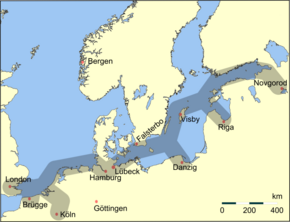Braunschweig
| Braunschweig | |
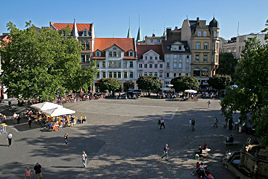 |
|
| Coat of arms | Location |
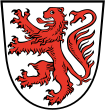 |
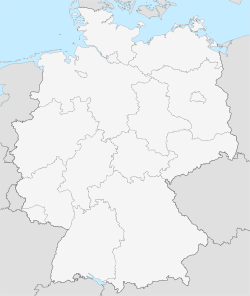 |
| Administration | |
| Country | Germany |
|---|---|
| State | Lower Saxony |
| District | Urban district |
| City subdivisions | 20 boroughs |
| Lord Mayor | Gert Hoffmann (CDU) |
| Governing parties | CDU / FDP |
| Basic statistics | |
| Area | 192.13 km² (74.2 sq mi) |
| Elevation | 75 m (246 ft) |
| Population | 245,810 (30/12/2007)[1] |
| - Density | 1,279 /km² (3,314 /sq mi) |
| Founded | before 1031 (probably in the 9th century) |
| Other information | |
| Time zone | CET/CEST (UTC+1/+2) |
| Licence plate | BS |
| Postal codes | 38100–38126 |
| Area codes | 0531, 05307, 05309 |
| Website | www.braunschweig.de |
Braunschweig [ˈbraʊnʃvaɪk], known as Brunswiek [ˈbrɔˑnsviːk] in Low German, is a city of 245,810 people (as of 31 December 2007), located in Lower Saxony, Germany. It is located north of the Harz mountains at the farthest navigable point of the Oker river, which connects to the North Sea via the rivers Aller and Weser.
The historic English name for Braunschweig is Brunswick.
Contents |
History
The date and circumstances of the town's foundation are unknown. Tradition maintains that Braunschweig was created through the merger of two settlements, one founded by Bruno II, a Saxon count who died before 1017 on one side of the river Oker - the legend gives the year 861 for the foundation - and the other the settlement of Count Dankward, after whom the still surviving Castle Dankwarderode (Dankward's clearing) is named. The town's original name of Brunswik is a combination of the name Bruno and wik, a place where merchants rested and stored their goods. The town's name therefore indicates an ideal resting-place, as it lay by a ford across the Oker River. Documents from the St. Magni Church from 1031 give the city's name as Brunesguik. Another explanation of the city's name is that it comes from Brand, or burning, indicating a place which developed after the landscape was cleared through burning.

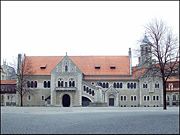
In the 12th century Duke Henry the Lion made Braunschweig the capital of his state and built the Cathedral. He became so powerful that he dared to refuse military aid to emperor Frederick I Barbarossa, which led to his condemnation and fall.
Braunschweig was a member of the Hanseatic League from the 13th century to the middle of the 17th century. In the 18th century Braunschweig was not only a political, but also a cultural centre. Emilia Galotti by Lessing and Goethe's Faust were performed for the first time in Braunschweig.
Braunschweig was the main residence of the rulers of the Duchy of Brunswick, which was a constituent state of the Holy Roman Empire until 1806 and of the German Empire from 1871. At the end of World War I the Duchy became the Free State of Brunswick within the Weimar Republic.
During World War II thousands of forced Eastern workers were brought to the city. During the years 1943-1945 at least 360 children taken away from the workers died in the Entbindungsheim für Ostarbeiterinnen.
In World War II, Braunschweig was a Sub-area Headquarters (Untergebiet Hauptquartier) of Military District (Wehrkreis) XI. It was also the garrison city of the 31st Infanterie Division, which took part in the invasions of Poland, Belgium, France, and Russia, and was largely destroyed during the German withdrawal from Russia. The city was severely damaged by Anglo-American aerial attacks. The air raid on 15 October, 1944 destroyed most of the Altstadt (old town), which had been the largest ensemble of half-timbered framework houses in Germany, as well as most of the churches. The Cathedral, which had been converted to a National shrine (German: Nationale Weihestätte) by the Nazi-Government, still stood.
After the war, Braunschweig ceased to be a capital when the Free State of Brunswick was dissolved by the Allied occupying authorities (most of its lands were incorporated in the newly formed state of Lower Saxony). The Cathedral was restored to its function as a Protestant church. The rebuilding of the city was intended to make it modern and automobile-oriented. A small section of the Altstadt survived the bombing and remains quite distinctive. In the 1990s efforts increased to reconstruct historic buildings that had been destroyed in the air raid. Buildings such as the "Alte Waage" (originally built in 1534) now stand again in their pre-war glory.
| 1811 | 1830 | 1849 | 1880 | 1890 | 1900 | 1925 | 1939 | 1950 | 1975 | 1989 | 2004 |
|---|---|---|---|---|---|---|---|---|---|---|---|
| 27,600 | 35,300 | 39,000 | 75,000 | 100,000 | 128,200 | 146,900 | 196,068 | 223,767 | 269,900 | 253,794 | 239,921 |
Main sights
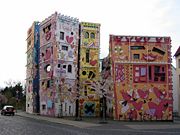
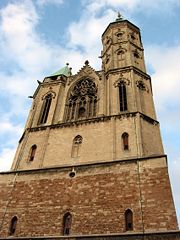
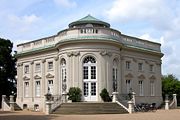
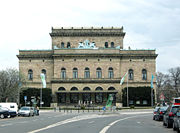

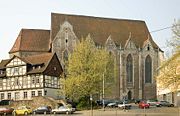
- The Burgplatz (Castle Square), comprising a group of buildings of great historical and cultural significance: the Cathedral (built at the end of the 12th century), the Burg Dankwarderode (a 19th-century reconstruction of the old castle of Henry the Lion), the Neo-Gothic Town Hall (built in 1893-1900), as well as some picturesque half-timbered houses, such as the Gildehaus (Guild House), today the seat of the Craftsman's Association. On the centre of the square stands a copy of the Burglöwe, a Romanesque statue of a Lion, cast in bronze in 1166. The original statue can be seen in the museum of the Castle Dankwarderode. Today the lion has become the true symbol of Braunschweig.
- The Altstadtmarkt ("old town market"), surrounded by old town hall (built between the 13th and the 15th centuries in Gothic style), and the Martinikirche (church of Saint Martin, from 1195).
- The Kohlmarkt ("coal market"), a market with many historical houses and a fountain from 1869.
- The Magniviertel (St Magnus' Quarter), a remainder of ancient Braunschweig, lined with cobblestoned streets, little shops and cafés, centered around the 13th-century Magnikirche (St Magnus' Church). Here is also the Rizzi-Haus, a highly distinctive, cartoonish office building designed by architect James Rizzi for the Expo 2000.
- The Romanesque and Gothic Andreaskirche (church of Saint Andrew), built mainly between the 13th and 16th centuries. The church was heavily damaged in World War II, and is expected to enter into its final stage of restoration in 2009 after some sixty years of intermittent work.
- The Gothic Aegidienkirche (church of Saint Giles), built in the 13th century, with an adjoining monastery, which is today a museum.
- The "Herzog Anton Ulrich Museum", a world renowed art museum and the oldest public museum in Germany (founded 1754).
- The Staatstheater (State Theater), newly built in the 19th century, goes back to the first standing public theater in Germany, founded in 1690 by Duke Anton Ulrich.
- The royal palace of Braunschweig was bombed in World War II and demolished in 1960. The exterior was rebuilt to contain a palace museum and shopping centre, which opened in 2007.
Attractions in the neighbourhood include:
- Celle: a town with old half-timbered houses and a castle.
- Hildesheim: a medieval town famous for its UNESCO-cultural heritage cathedrals, market place and old half-timbered houses.
- Hamelin: a town famous for the folk tale of the Pied Piper of Hamelin
- Wolfenbüttel: the Residenzstadt (residential city) of the Dukes of Brunswick-Lüneburg for several centuries, Wolfenbüttel is home to a Wasserburg (castle surrounded by a moat) and the Bibliotheca Augusta (Herzog August Bibliothek, or the Duke August library) housing the largest collection of medieval manuscripts in Europe. The city is historically important also for its numerous half-timber houses, many of which date back several centuries since Wolfenbüttel was left largely untouched by WWII.
Transport
Automobile
Two main autobahns serve Braunschweig, the A2 (Berlin—Hannover—Dortmund) and the A39 (Salzgitter—Wolfsburg). City roads are generally wide, built after World War II to support the anticipated use of the automobile. There are several car parks in the city.
Bicycle
Many residents travel around town via bicycle using an extensive system of bicycle-only lanes. The main train station includes a bicycle parking area.
Train
The city is on the main rail line between Frankfurt and Berlin. Deutsche Bahn (German Railways) serves the city with local, inter-city and high-speed InterCityExpress (ICE) trains, with frequent stops at the Hauptbahnhof (main train station).
Tram
The city has an inexpensive and extensive 35 km electric tram system. First opened in 1897, it has been modernized, including a 3.2 km extension in 2007.[2]
Sister Cities
 Bandung, Indonesia (since 1960)
Bandung, Indonesia (since 1960) Nîmes, France (since 1962)
Nîmes, France (since 1962) Bath, United Kingdom (since 1971)
Bath, United Kingdom (since 1971) Sousse, Tunisia (since 1980)
Sousse, Tunisia (since 1980) Qiryat Tivon, Israel (since 1985/1986)
Qiryat Tivon, Israel (since 1985/1986) Magdeburg, Germany (since 1987)
Magdeburg, Germany (since 1987) Kazan, Russian Federation (since 1988)
Kazan, Russian Federation (since 1988) Omaha, Nebraska United States (since 1992)
Omaha, Nebraska United States (since 1992)
Miscellaneous
Many other geographical names are named after Braunschweig such as New Brunswick in Canada due to the personal union of the Duchy of Hanover with Great Britain from 1714 to 1837 (see House of Hanover, also referred to as the House of Brunswick, Hanover line). For a list of places named after Braunschweig see Brunswick (disambiguation).
Research and Science
Braunschweig has been an important industrial area. Today it is known for its University and research institutes, mainly the Federal Agricultural Research Centre and the Physikalisch-Technische Bundesanstalt (PTB). The PTB Braunschweig maintains the atomic clock responsible for the DCF77 time signal and the official German time. The region of Braunschweig is the most R&D-intensive area in the whole European Economic Area investing a whopping 7.1% of its GDP for research & technology. (Eurostat, 2006). Braunschweig was named Germany's City of Science 2007 (German: Stadt der Wissenschaft 2007).
Education
Also located in Braunschweig is the "Martino-Katharineum", a secondary school founded in 1415. It had such famous pupils as Carl Friedrich Gauss, Hoffmann von Fallersleben, Richard Dedekind and Louis Spohr. Since 2005, Braunschweig has an international school.
Economy
Braunschweig is the home of two piano companies, both known worldwide for the high quality of their instruments: Schimmel and Grotrian-Steinweg (cf. Steinway). Both companies were founded in the 19th century.
Culture
Braunschweig is famous for Till Eulenspiegel, a medieval jester who played many practical jokes on its citizens. It also had — and still has — many breweries, and still a very peculiar kind of beer is made called Mumme (see de:Braunschweiger Mumme), first quoted in 1390, a malt-extract that was shipped all over the world.
Near Braunschweig at Cremlingen-Abbenrode, there is a large medium wave transmitter, which transmits the program of "Deutschlandfunk" on 756 kHz, the Cremlingen transmitter.
The Braunschweig-Wolfsburg Regional Airport (BWE / EDVE) is located north of the city at , elev. 295 ft.
Braunschweiger liverwurst is named after the city.
Sports
Braunschweig's local football team is Eintracht Braunschweig. Founded in 1895, the club can look back on a long and chequered history. It won the German football championship in 1967. Despite playing the German 3rd Soccer division now (2008-2009 season), the club still attracts a large number of supporters.
The Braunschweig Lions is the city's American football team, seven times German Bowl Defender and two times Eurobowl champion.
External links
- Official website (English)
- Braunschweig - 360° Panoramas
- International School Braunschweig-Wolfsburg
- Braunschweig travel guide from Wikitravel
References
|
||||||||||||||||||||||||||
|
|||||||||||

